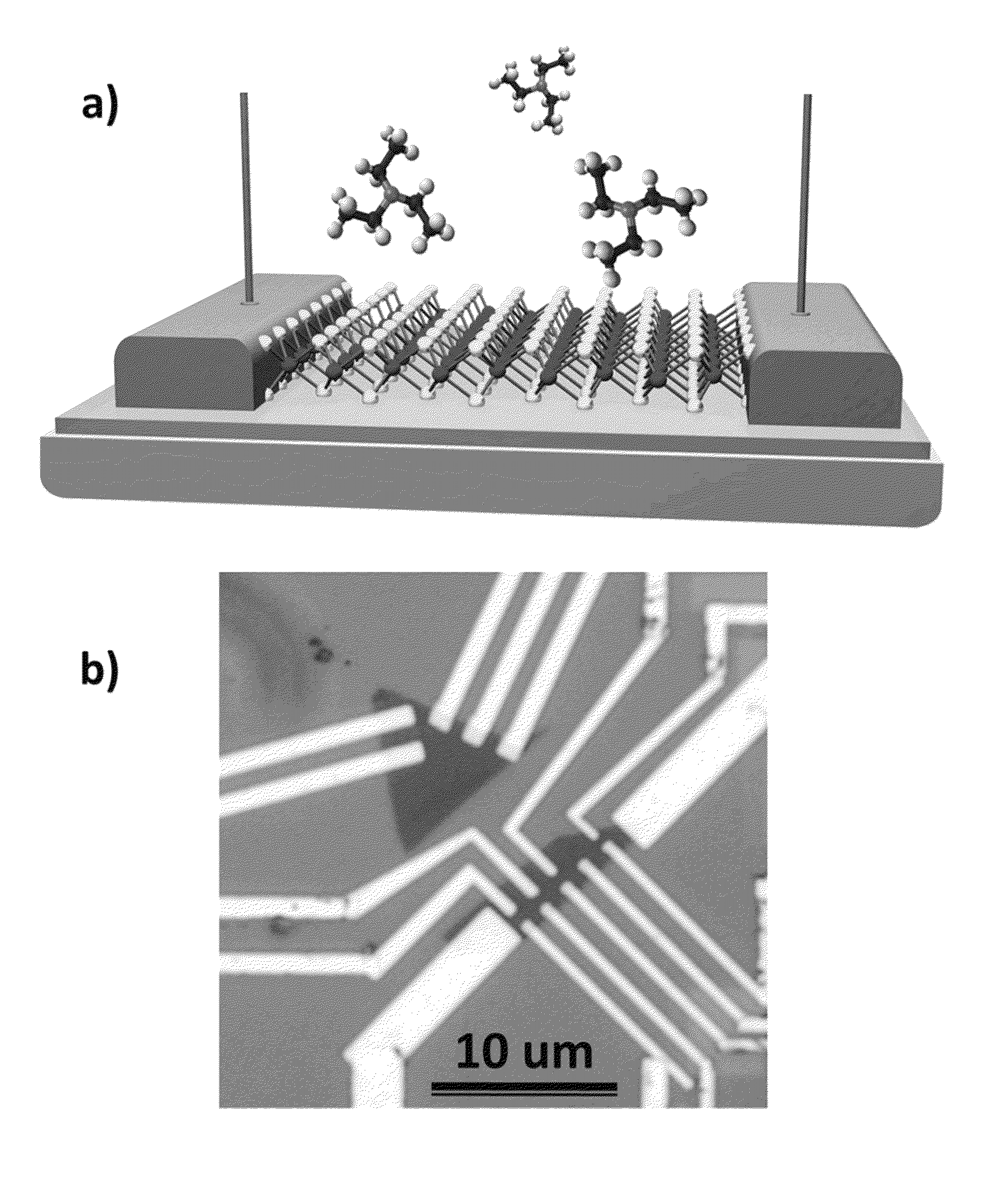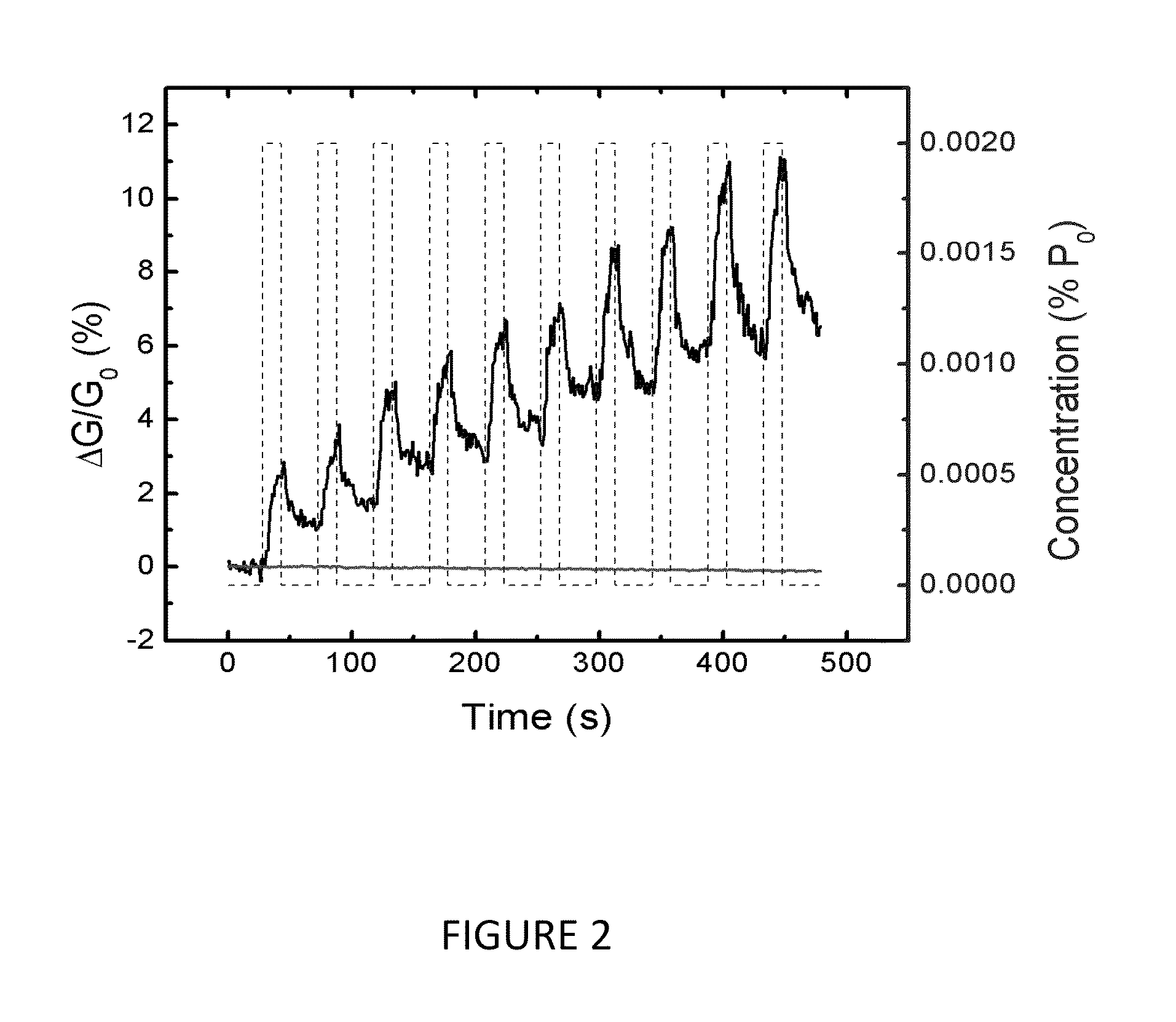Low-dimensional material chemical vapor sensors
a technology of chemical vapor sensors and low-dimensional materials, applied in the direction of material impedance, material analysis, instruments, etc., can solve the problems of sensors incredibly fast to react to vapor analytes, little selectivity, and inability to detect analytes accurately
- Summary
- Abstract
- Description
- Claims
- Application Information
AI Technical Summary
Benefits of technology
Problems solved by technology
Method used
Image
Examples
example 1
[0025]MoS2 is mechanically exfoliated onto SiO2 / Si wafers.
[0026]Monolayer flakes are identified with a combination of optical inspection, atomic force microscopy (AFM), and Raman Spectroscopy.
[0027]Electron beam lithography with a methylmethacrylate (MMA) / polymethylmethacrylate (PMMA) layer is used to define trenches in the layer for the deposition of patterned metal contacts to the MoS2 film.
[0028]Ti / Au, Au, or Pt is deposited in the trenches by electron beam evaporation.
[0029]Similar sensor devices are made using the same methods with chemical vapor deposition (CVD) grown semiconducting single walled CNT meshes and CVD grown monolayer graphene films. The sensors are mounted into a specially built chemical sensor testing apparatus and contacts are made to the sensors using microprobe positioners.
[0030]Nitrogen gas is bubbled through a select liquid analyte and sensors are exposed to the mixture, with the concentration of analyte in the mixture controlled using a solenoid valve and ...
example 2
[0038]MoS2 is a layered compound with weak interaction between the layers, similar to graphite, and is widely used as a lubricant. Each layer consists of a plane of molybdenum atoms sandwiched between layers of sulfur atoms as shown in FIG. 1(a). It is relatively nonreactive at moderate temperatures (<350° C.)—it is difficult to oxidize and unaffected by dilute acids. In contrast with graphite / graphene, it is a semiconductor with an indirect bandgap (1.2 eV) and exhibits catalytic properties useful for hydrodesulfurization.
[0039]Recent work has shown that a single monolayer of MoS2 exhibits properties markedly different from the bulk: it transitions from an indirect to direct gap semiconductor (˜1.9 eV) with high luminescence efficiency and can be used as the transport channel in a field effect transistor with high on / off ratio and pronounced photoresponse.
[0040]Our sensor devices were fabricated from monolayer flakes of MoS2 that were exfoliated from bulk samples using the “Scotch ...
example 3
[0054]For comparison, similar data were acquired for planar sensors fabricated from (a) monolayer graphene grown by chemical vapor deposition on copper and (b) a carbon nanotube (CNT) network consisting of a dense array of CNTs forming an electrically continuous thin film, as the transport / sensor channel.
[0055]These data were recorded where AG / G0 is plotted for a sequence of TEA pulses (10 s on, 20 s off) of 0.025% P0 (12 ppm) concentration. The CNT response amplitude to a single pulse is comparable to that of the MoS2 monolayer, while that of the graphene sensor is much smaller.
[0056]However, in marked contrast with the response exhibited by the MoS2, the graphene and CNT conductivity both decrease with TEA exposure, and the data are superposed on a negatively sloped background.
[0057]The opposite response of the MoS2 and graphene / CNT sensors can be understood to first order by considering the transient charge perturbation to the sensor material upon interaction with the TEA molecul...
PUM
| Property | Measurement | Unit |
|---|---|---|
| thick | aaaaa | aaaaa |
| thick | aaaaa | aaaaa |
| temperatures | aaaaa | aaaaa |
Abstract
Description
Claims
Application Information
 Login to View More
Login to View More - R&D
- Intellectual Property
- Life Sciences
- Materials
- Tech Scout
- Unparalleled Data Quality
- Higher Quality Content
- 60% Fewer Hallucinations
Browse by: Latest US Patents, China's latest patents, Technical Efficacy Thesaurus, Application Domain, Technology Topic, Popular Technical Reports.
© 2025 PatSnap. All rights reserved.Legal|Privacy policy|Modern Slavery Act Transparency Statement|Sitemap|About US| Contact US: help@patsnap.com



